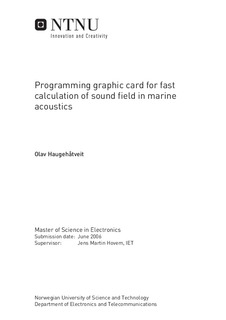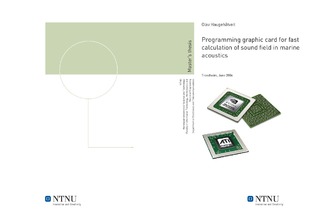| dc.contributor.advisor | Hovem, Jens Martin | nb_NO |
| dc.contributor.author | Haugehåtveit, Olav | nb_NO |
| dc.date.accessioned | 2014-12-19T13:44:32Z | |
| dc.date.accessioned | 2015-12-22T11:42:34Z | |
| dc.date.available | 2014-12-19T13:44:32Z | |
| dc.date.available | 2015-12-22T11:42:34Z | |
| dc.date.created | 2010-09-05 | nb_NO |
| dc.date.issued | 2006 | nb_NO |
| dc.identifier | 349017 | nb_NO |
| dc.identifier.uri | http://hdl.handle.net/11250/2369523 | |
| dc.description.abstract | Commodity computer graphics chips are probably today’s most powerful computational hardware one can buy for money. These chips, known generically as Graphics Processing Units or GPUs, has in recent years evolved from afterthought peripherals to modern, powerful programmable processor. Due to the movie and game industry we are where we are to today. One of Intel’s co-founder Gordon E. Moore said once that the number of transistors on a single integrated chip was to double every 18 month. So far this seems to be correct for the CPU. However for the GPU the development has gone much faster, and the floating point operations per second has increased enormously. Due to this rapid evolvement many researchers and scientists has discovered the enormous floating point potential can be taken advantage of, and a numerous applications has been tested such as audio and image algorithms. Also in the area of marine acoustics this has become interesting, where the demand for high computational power is increasing. This master report investigates how to make a program capable to run on a GPU for calculating an underwater sound field. To do this a graphics chips with programmable vertex and fragment processor is necessary. Programming this will require graphics API like OpenGL, a shading language like GLSL, and a general purpose GPU library like Shallows. A written program in Matlab is the basic for the GPU program. The goal is to reduce calculation time spent to calculate a underwater sound field. From this the increment from Matlab to GPU was found to be around 40-50 times. However if Matlab was able to calculate the same number of rays as maximum on the GPU, the increment would probably be bigger. Since this study was done on a laptop with nVidia GeForce Go 6600 graphics chip, a higher gain would theoretically be obtainable by a desktop graphics chip. | nb_NO |
| dc.language | eng | nb_NO |
| dc.publisher | Institutt for elektronikk og telekommunikasjon | nb_NO |
| dc.subject | ntnudaim | no_NO |
| dc.title | Programming graphic card for fast calculation of sound field in marine acoustics | nb_NO |
| dc.type | Master thesis | nb_NO |
| dc.source.pagenumber | 62 | nb_NO |
| dc.contributor.department | Norges teknisk-naturvitenskapelige universitet, Fakultet for informasjonsteknologi, matematikk og elektroteknikk, Institutt for elektronikk og telekommunikasjon | nb_NO |

